

 HOME | ÍNDICE POR TÍTULO | NORMAS PUBLICACIÓN
HOME | ÍNDICE POR TÍTULO | NORMAS PUBLICACIÓN Espacios. Vol. 37 (Nº 02) Año 2016. Pág. 7
Thiago Duarte MOTA 1 4, Rinaldo BENEVIDES 1, Arnaldo Levy LASSANCE CUNHA 2, Inês SANTOS 2, Marcia Melo RAMOS 2, Fabiana Delvizio BADINI 3, Rosana Montechiare DELGADO 3, Katia Leituga Martins de CARVALHO 3, Mario do Nascimento MORAES 1, Marcos Aurélio Vasconcelos de FREITAS 1
Recibido: 01/09/15 • Aprobado: 01/10/2015
ABSTRACT: Within an organization, the management policies that aim to streamline processes, facilitate the adaptation and implement strategies with the ability to offer new products and services, become relevant benefits, in order to optimize the allocation of resources, reduce costs and bring greater efficiency to the administration as a whole. In this sense, projects related to information technology (IT) are important in the search for expanding the strategic possibilities of the organization, through the Internet-based applications, incorporating services and technologies that provide support to the operation, management, analysis and decision making. Thus, the Secretariat of Surveillance, Sanitary Inspection and Zoonoses Control (S/SUBVISA), organization that integrates the direct administration of the municipality of Rio de Janeiro (RJ) - Brazil, has developed a project to create an information technology-based tool that can provide support for the development of a self-declaration system (SISVISA) related to the activities of S/SUBVISA. The main objective of the project under development is the elaboration of the self-declaration system (SISVISA) related to the activities of S/SUBVISA through IT-based tools in order to streamline and optimize the formalities and services of this organization. Given the project under development, this study aimed to define and develop the work breakdown structure (WBS) and to map the processes related to the system as part of the planning stage, identifying key processes that can be used in the information flow, generating the necessary flowcharts. |
RESUMO: Dentro de uma organização, as políticas de gestão que visam simplificar os processos, facilitar a adaptação e implementação de estratégias com a capacidade de oferecer novos produtos e serviços, tornam-se benefícios relevantes, a fim de otimizar a alocação de recursos, reduzir custos e trazer maior eficiência ao administração como um todo. Neste sentido, os projetos relacionados à tecnologia da informação (TI) são importantes na busca de ampliar as possibilidades estratégicas da organização, através das aplicações baseadas na Internet, incorporando serviços e tecnologias que fornecem suporte à operação, gestão, análise e tomada de decisão . Assim, a Secretaria de Vigilância, Vigilância Sanitária e Controle de Zoonoses (S / SUBVISA), organização que integra a administração directa do município do Rio de Janeiro (RJ) - Brasil, desenvolveu um projeto para criar uma ferramenta baseada em tecnologia da informação que pode fornecer suporte para o desenvolvimento de um sistema de auto-declaração (SIS VISA) relacionados com as actividades de S / SUBVISA. O principal objectivo do projecto em desenvolvimento é a elaboração do sistema de auto-declaração (SISVISA) relacionados com as actividades da S / SUBVISA através de ferramentas baseadas em TI, a fim de racionalizar e otimizar as formalidades e os serviços desta organização. Dado o projeto em desenvolvimento, este estudo teve como objetivo definir e desenvolver a estrutura analítica do projeto (EAP) e mapear os processos relacionados com o sistema, como parte da fase de planejamento, identificando os processos-chave que podem ser usados no fluxo de informações, gerando a fluxogramas necessárias. |
The intense technological change introduced by globalization leads to discussion about the need for companies to seek technological solutions that enable the integration of its global activities and regional needs (ARAUJO and LAURINDO, 2008). The integration of business strategies, production and information technology (IT) structure can be decisive to reach collective efficiency (GUNASEKARAN and NGAI, 2004; ARAUJO and LAURINDO, 2008).
Some authors, such as ALTER (1992), distinguish between Information Technology and Information Systems, restricting the first expression only to the technical aspects, while the second corresponds to the issues related to workflow, people and information involved. Other authors, however, use the term Information Technology covering both aspects (HENDERSON and VENKATRAMAN, 1993; KEEN, 1993). According to Weil (1992), Keen (1993) and Luftman et al. (1993), among others, the concept of Information Technology is broader and more comprehensive, involving data processing, information systems, software engineering, computer science or the set of hardware and software, telecommunications, automation and multimedia resources, as well as human, administrative and organizational aspects.
Thus, it can be seen that the IT has expanded over time, from a traditional orientation of administrative support to a strategic role within the organization. The vision of IT as a strategic competitive tool has been discussed and emphasized, as it not only supports the existing business operations, but also allows the feasibility of new business strategies (LAURINDO et al., 2001).
Araujo and Laurindo (2008) point out that IT can represent a way to extend the strategic possibilities of the company, mainly through Internet-based applications, revolutionizing the strategy and how to conduct business. The main focus is on the choice of operations strategy, responsible for the efficient development of new products, services and processes that enables to achieve the needs and expectations of customers. The IT projects, mostly, incorporate project applications, services and technologies that provide support for the operation, management, analysis and decision making (RABENSCHLAG et al., 2012).
The IT investments aim to take advantage of technological advances and their effects, and thus achieve productivity gains, which are often associated with financial results (TORRES, 1995). In the view of the strategic alignment model, "when investing" should represent the consensus of building an information systems infrastructure and processes that is compatible with the size and the need for organizational infrastructure and processes, focusing on reaching, effectively and efficiently, the alignment between business strategies and IT strategies (ARAUJO and LAURINDO, 2008).
In the context of a highly competitive business market, the management policies that aim to speed processes, as well as procedures to facilitate the adaptation and implementation of strategies with the ability to offer new products and services, become relevant advantages and, in some sectors, pre-requirements for the survival of organizations. Thus, nowadays, the best management practices adopted by the business community, as for example, IT projects and tools, have been increasingly absorbed by the public sector to try to transform the planning into results, optimize the allocation of resources, reduce costs and bring greater efficiency to the administration as a whole (RABENSCHLAG et al., 2012).
Given the above, the Secretariat of Surveillance, Sanitary Inspection and Zoonoses Control (S/SUBVISA), organization that integrates the direct administration of the municipality of Rio de Janeiro (RJ) - Brazil, has developed a project to create an information technology-based tool that can provide support for the development of self-declaration system (SISVISA) related to the activities of S/SUBVISA. This system would be of great value, streamlining and optimizing the procedures and services of the organization, such as licenses processes and control of inspections and supervisions.
The S/SUBVISA is the organization responsible for the protection and defense of population health by preventing risks regarding hygienic-sanitary aspects. Thus, this organization promotes the hygienic-sanitary security of environments, products and services regarding activities such as handling, preservation and transportation of food, as well as buildings of health facilities and for economic exploitation concerning foodstuffs and animals raising.
The main objective of the project under development is the elaboration of the SISVISA, a self-declaration system related to the activities of S/SUBVISA, through tools based on information technology, in order to streamline and optimize the business processes and services of this organization, facilitating the implementation and follow-up activities such as licensing, inspection control and supervision.
To achieve the main objective, this study aimed to define and develop the work breakdown structure (WBS), which can guide and assist the development of SISVISA. In addition to the WBS, the study intend to map the processes related to the system as part of the planning stage, identifying key processes that can be used in the information flow, generating the necessary flowcharts.
The methodology used in the system planning (SISVISA) is based on the PMBOK® Guide of the PMI®, with the application and integration of project management process groups that support the development of the project. For better manage of the activities of these processes, templates were used. Those templates were continuously improved in accordance with the lessons learned and best practices identified.
As part of the planning, the mapping of processes related to the system (SISVISA) was done, using BIZAGI MODELER software.
The platform is developed in Web with Microsoft .NET architecture, and programming language C #; for encoding Information Systems. The SQL Server 2008 R2 relational database management system was already used.
During the development of the necessary operations, compiling, testing, distribution and execution will be automated with Team Foundation (http://msdn.microsoft.com/en-us/vstudio/ff637362.aspx) or by tools: for integration continues, the Jenkins (http://jenkins-ci.org/); for automated inspection of source code, Sonar (http://www.sonarsource.com/products/plugins/languages/c-sharp); for managing test cases, the Testlink (http://testlink.org); for implementing automated functional testing, Selenium (http://docs.seleniumhq.org); for repositories and file versioning, Subversion (http://subversion.apache.org); called for opening, JIRA (https://www.atlassian.com/software/jira); for carrying out performance tests, (JMeter http://jmeter.apache.org).
The entire development of the project is being built on the Microsoft Visual Studio 2012 IDE.
The documentation is being done in HTML, with the production of xml markup inserted in the comments of the source code and classes with descriptions of methods, properties and domain where applicable, all the standard "XML Documentation Comments". (http://msdn.microsoft.com/en-us/library/b2s063f7.aspx).
We used the Framework based on best practices for web application development ASP.Net and uses the Visual Studio IDE features for developing its entirety, in use since the templates for creating ASP.Net Web Forms and ASP.Net projects MVC Web to the native features of the .Net Framework, Membership security components, Unit Testing, Web Services, Web API, and others.
In the system architecture, the used domain modeling strategy is the DDD (Domain Driven Design), where all the domain classes must have their unit tests; the type repository classes should implement the persistence through the Entity Framework or NHibernate; unit tests do not access other external services (System Database Manager - DBMS, network, etc.); the acceptance tests are automated after its approval on the Team Foundation or Selenium (http://seleniumhq.org/); dependency injection is prioritized over the similar design patterns (http://martinfowler.com/articles/injection.html);
In the user interface, we grip the pages that make up the graphical user interface - GUI in the view layer are in the XHTML standard (http://www.w3.org/TR/xhtml1/) or HTML5 (http: / /www.w3.org/TR/html5) and is not being used any conditional logic and / or iteration in the source code of the GUI pages (instructions if, for, scriplets, javascript, etc.). The identities of colors and visual features are managed with the use of CSS2 (http://www.w3.org/Style/CSS2/) or CSS3 standard in the City Hall of Rio de Janeiro. Images have standard dimensions and are cataloged in an area called Images (http://www.abraweb.com.br/site/banners.php) and output reports will have the following formats for export html and pdf, txt, json, xml and csv.
In addressing management and project configuration, we all artifacts are versioned in the repositories; the ramifications created in versionador have expiration date and the version numbering policy will have versions of applications are numbered as follows: ABC, where A is the production delivery number for the production, B approval of the delivery number for the approval and C delivery number validation for validation.
Within this context we have the application running on a server running Windows Server operating system with Internet Information Service IIS and Bank of SQL Server 2008 R2 data.
The identification of terminal elements (products, services and results to be made in the project) was done by the Work Breakdown Structure (WBS) shown in Figure1 and it is structured in an exhaustive and hierarchical tree (from generally to more specific) oriented to deliveries, stages of life cycle or sub-projects (deliverables) that need to be done to complete the project.
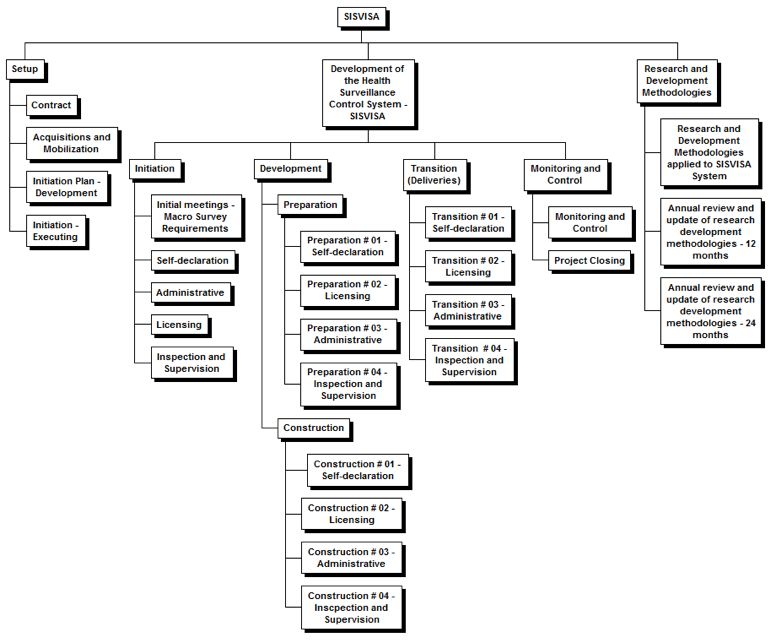
Figure 1: Work breakdown structure
The mapping process, resulted in 5 main flowcharts. Each one of these have processes and activities related to self-declaration licensing process, according to Figure 2: Licensing Request; Request Analysis; Fulfillment of requirements; Dismissed; Deferred.
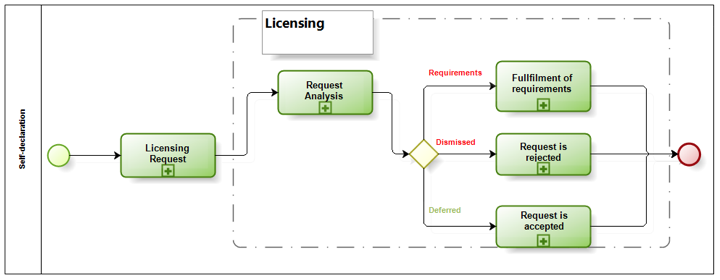
Figure 2: Self Declaration flowchart
In the Licensing request process, the user must perform some actions for completing the self-declaration (Figure 3). Also within the licensing application process, it is presented the guidelines process for self-declaration (Figure 4).

Figure 3: Licensing request process
-----
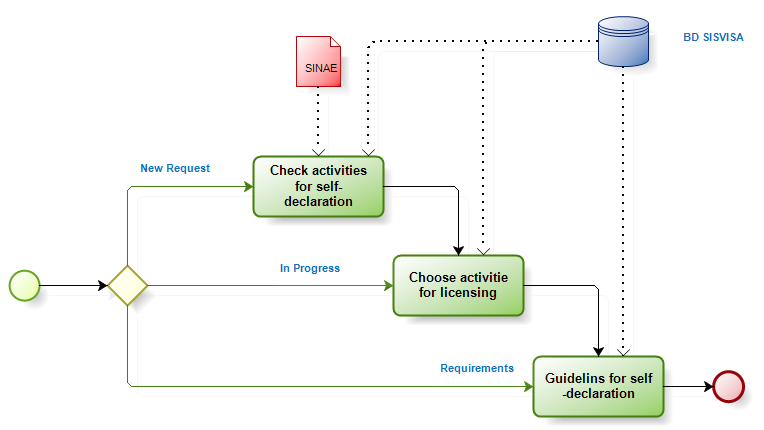
Figure 4: Guidelines for Self-declaration
In the Request Analysis process, all the self-declaration should be examined by an official of SUBVISA from the area related to the economic activity to be licensed (Figure 5). After the analysis for licensing by self-declaration, the request may be deferred (Figure 6), dismissed (Figure 7) or entering in requirements (Figure 8). In the Fulfillment of requirements process, the applicant can meet the requirements in SISVISA by changing the self-declaration or providing the required information for compliance to a S/SUBVISA sector.
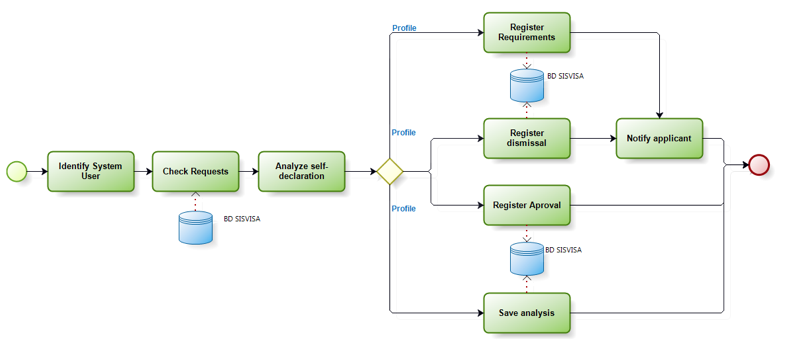
Figure 5: Request Analysis process
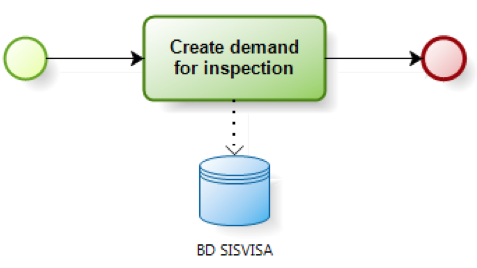
Figure 6: Deferred process
-----

Figure 7: Dismissed Process
-----

Figure 8: Fulfillment of requirements process
-----
Within an organization, the management policies that aim to streamline processes facilitate the adaptation and implement strategies with the ability to offer new products and services, become relevant benefits, in order to optimize the allocation of resources, reduce costs and bring greater efficiency to the administration as a whole.
The development of the sanitary surveillance management system (SISVISA) for control, management, supervision and inspection of the sanitary activities will contribute to improve the surveillance process. This project is innovative and can be useful to improve the S/SUBVISA activities in the city of Rio de Janeiro/RJ, Brazil.
For the success and achievement of system objectives it is extremely important the execution of a well-planned scheme, with a good analytical projects structure (WBS), to meet the requirements specified for S/SUBVISA. It is expected that the self-declaration module will be available still this year for use by S/SUBVISA.
In this context, it is expected as effect of the project, among others: Completion of the sanitary licensing by online self-declaration; Streamlining the formalities of administrative processes, reducing the period for licensing authorization; Optimization of inspection procedures, reducing material and human resources involved; Increased access to services associated with health surveillance for the population of the municipality of Rio de Janeiro.
In addition, the system will enable greater reliability and transparency in the activities of S/SISVISA since currently, inspectors are directed to specific facilities and end up creating social and/or financial ties to the owner or local manager. The system in question will allow the randomly schedule of the establishments to be inspected, as well as the inspector designated for inspection.
ALTER, S. Information Systems: a management perspective. Addison-Wesley Publishing Co.Massachusetts, 1992.
ARAUJO, J.A.R.; LAURINDO, F.J.B. Como, quando e quanto investir em tecnologia de informação: Uma análise de múltiplos casos. How, when and how much to invest in information technology: an analysis of multiple cases. Espacios, 29 (1), 2008. Pág. 21
GUNASEKARAN, A.; NGAI, E.W.T. Information Systems in Supply Chain Integration and Management. European Journal of Operational Research, 159, 269-295, 2004.
HENDERSON, J.C.; VENKATRAMAN, N. Strategic Alignment: Leveraging Information Technology for Transforming Organizations. IBM Systems Journal, 32 (1), 4-16, 1993.
KEEN, P.G.W. Information Technology and the Management Theory: The Fusion Map. IBM Systems Journal, 32 (1), 17-38, 1993.
LAURINDO, F.J.B.; SHIMIZU, T.; CARVALHO, M.M.; RABECHINI JR, R. The Role of Information Technology (IT) in the Strategy of Organizations. Gestão & Produção, 8 (2), 160-179, 2001.
LUFTMAN, J.N.; LEWIS, P.R.; OLDACH, S.H. Transforming The Enterprise: The Alignment Of Business And Information Technology Strategies. IBM Systems Journal, 32 (1), 198-221, 1993.
RABENSCHLAG, D.R.; RORATTO, R.; DIAS, E.D. Fatores de risco no gerenciamento de projetos de tecnologia da informação no setor público brasileiro. Risk points in project management of information technology in brazilian public management. Espacios, 33 (8), 2012. Pág. 11
TORRES, N.A. Competitividade empresarial com a tecnologia de informação; Business competitiveness with information technology. São Paulo, Makron Books, 1995.
WEIL, P. The Relationship Between Investment In Information Technology And Firm Performance: A Study of The Valve Manufacturing Sector. Information Systems Research, 3 (4), 307-333, 1992.
1. Virtual Institute of Global Change - IVIG Coppe - Alberto Luiz Coimbra Institute for Graduate Studies and Research Engineering- Federal University of Rio de Janeiro
2. SUBVISA - Surveillance Secretariat, Sanitary Inspection and Animal Control - City Hall of Rio de Janeiro City;
3. IPLAN Municipal Enterprise Computing for Rio de Janeiro - City Hall of Rio de Janeiro City
4. Corresponding author: thiago.mota@ivig.coppe.ufrj.br